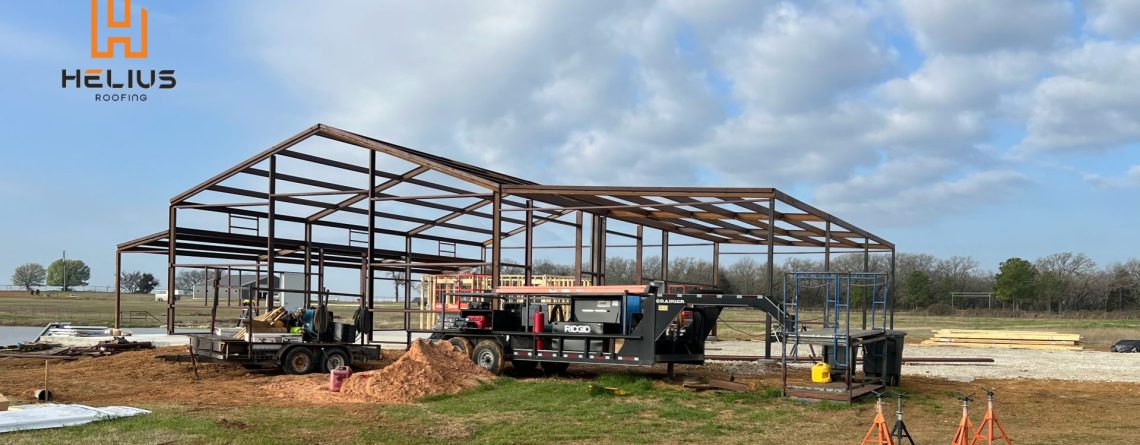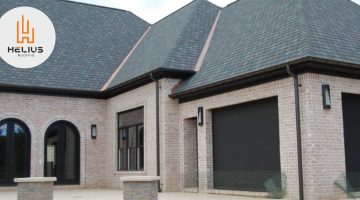By Helius Roofing & Construction

When it comes to constructing buildings, one of the biggest decisions you’ll face is whether to use metal or wood. While both materials have their merits, metal buildings have increasingly become the preferred choice for residential, commercial, and industrial projects. The durability, affordability, and versatility of metal structures make them a superior option over traditional wood construction.
At Helius Roofing & Construction, we specialize in metal buildings, and we understand the key benefits they offer. In this article, we’ll dive deep into the top advantages of metal buildings over wood and why you should consider choosing metal for your next construction project.
1. Durability and Strength
One of the most significant advantages of metal buildings over wood is their superior durability and strength. Metal structures, especially those made from steel, are highly resistant to external forces, such as extreme weather conditions, pests, and fire.
Weather Resistance
Metal buildings can withstand harsh environmental conditions much better than wood structures. Steel, for example, is resistant to heavy rain, snow, wind, and even seismic activity. In contrast, wood is susceptible to water damage, warping, and rot when exposed to moisture over time. Metal buildings don’t absorb water and are less likely to suffer structural damage in areas prone to storms or high winds.
Pest Resistance
Termites, carpenter ants, and other wood-boring insects can wreak havoc on a wooden building, causing structural damage that can be costly to repair. Metal buildings are naturally resistant to pests and insects, eliminating the risk of infestation and the need for regular pest control treatments.
Fire Resistance
Wood is highly flammable, making wooden structures vulnerable to fire damage. Metal buildings, on the other hand, are non-combustible. Steel framing does not catch fire, and metal roofing materials are less likely to ignite, making metal buildings safer in areas prone to wildfires or electrical hazards.
2. Low Maintenance Requirements
Metal buildings require significantly less maintenance than wooden structures. Wood buildings need regular inspections for rot, mold, and insect infestations, as well as frequent repainting and repairs due to warping or weather damage.
In contrast, metal buildings are far more low-maintenance. Steel and aluminum are highly durable and can last for decades with minimal upkeep. Most metal building components, such as roofing and siding panels, come with protective coatings like galvanization or powder coating, which prevent rust and corrosion. Occasional cleaning and inspections are usually all that’s needed to keep a metal building in excellent condition.
Rust Protection
Metal buildings are designed with rust-resistant materials, such as galvanized steel or aluminum, that prevent corrosion. With proper coatings and regular inspections, rust is rarely an issue, even in humid or coastal environments.
3. Longevity and Sustainability
Metal buildings are built to last much longer than wood buildings. Steel, in particular, has a lifespan of several decades, making it a cost-effective long-term solution for residential and commercial projects. Wood, on the other hand, can degrade over time due to environmental exposure, requiring costly repairs or replacements.
Eco-Friendly
Metal buildings are more sustainable than wood buildings for several reasons. Steel is one of the most recyclable materials in the world, meaning that when a metal building reaches the end of its useful life, the metal components can be recycled and repurposed. In contrast, wood structures contribute to deforestation and are less sustainable in the long run.
Many metal buildings are made from recycled materials, reducing their environmental impact during production. Additionally, the energy efficiency of metal structures often outperforms that of wood buildings, further reducing their carbon footprint.
Reduced Waste
Metal building components are prefabricated in factories, allowing for precise measurements and minimizing material waste during construction. Wood construction often involves more cutting and trimming on-site, which leads to higher levels of waste.
4. Cost Efficiency
While the upfront cost of a metal building may be slightly higher than that of a wood structure, the overall cost-efficiency of metal buildings is much greater in the long run. The combination of lower maintenance requirements, longevity, and energy savings makes metal buildings a more affordable option over time.
Lower Insurance Costs
Because metal buildings are more resistant to fire, pests, and weather damage, they are often cheaper to insure than wooden buildings. Insurance companies recognize the reduced risk associated with metal structures and typically offer lower premiums for metal building owners.
Fewer Repairs
Wooden buildings are prone to rot, warping, and pest infestations, which can lead to frequent repairs and maintenance costs. Metal buildings, on the other hand, require fewer repairs due to their superior durability and resistance to damage.
5. Energy Efficiency
Metal buildings offer excellent energy efficiency, especially when combined with modern insulation materials and reflective coatings. Steel panels can be coated with reflective finishes that help reduce heat absorption, keeping the interior of the building cooler in the summer. This can lead to lower energy costs for cooling, especially in warmer climates.
Insulation Options
Metal buildings can be easily insulated to improve their energy efficiency. High-quality insulation materials, such as spray foam or rigid board insulation, can be applied to the walls and roof of a metal building to keep it warm in the winter and cool in the summer. Metal buildings can also accommodate insulated metal panels (IMPs), which provide excellent thermal performance and help reduce heating and cooling costs year-round.
Natural Lighting
Metal buildings can be designed to incorporate natural lighting solutions, such as skylights or translucent panels, which reduce the need for artificial lighting during the day. This not only lowers electricity costs but also enhances the overall comfort and usability of the building.
6. Versatility and Design Flexibility
Metal buildings offer more design flexibility than wooden buildings. Steel framing can support wider spans without the need for internal columns, allowing for more open, customizable floor plans. This makes metal buildings ideal for large commercial spaces, warehouses, and agricultural structures where open space is a priority.
Expandable
Metal buildings can be easily expanded or modified in the future if your needs change. Unlike wood structures, which require extensive construction work to accommodate additions, metal buildings can be expanded by adding extra panels or extending the frame.
Modern Aesthetic
Metal buildings offer a sleek, modern aesthetic that can be customized to suit your specific style preferences. Metal panels are available in a variety of colors, textures, and finishes, allowing you to create a unique, visually appealing structure. Whether you prefer a minimalist, industrial look or a more traditional design, metal buildings can be tailored to meet your architectural vision.
7. Faster Construction Time
Another key advantage of metal buildings over wood is the speed of construction. Metal building components are typically prefabricated in a factory, allowing for quick and efficient assembly on-site. Prefabrication reduces the time spent on labor and minimizes the potential for delays due to weather or material shortages.
Simplified Construction Process
Since metal buildings are often sold as pre-engineered kits, they come with all the necessary components for assembly. This simplifies the construction process and allows for faster completion times compared to wood buildings, which require more on-site cutting, measuring, and customization.
Reduced Labor Costs
Faster construction times also mean lower labor costs. With fewer man-hours required to assemble a metal building, you can save on labor expenses, making metal buildings an affordable and efficient option for both residential and commercial projects.
Conclusion
When comparing metal buildings to wood, the advantages of metal are clear. Metal buildings offer superior durability, lower maintenance, cost efficiency, and design flexibility, making them the ideal choice for a wide range of construction needs. Whether you’re building a residential garage, a commercial warehouse, or an agricultural facility, metal structures provide long-lasting performance and peace of mind.
At Helius Roofing & Construction, we specialize in designing and constructing high-quality metal buildings that meet your specific needs. Contact us today to learn more about the benefits of metal buildings and how we can help you with your next construction project.











